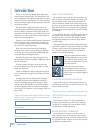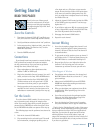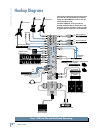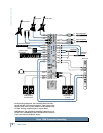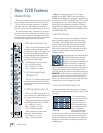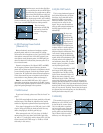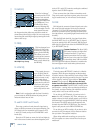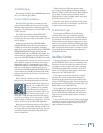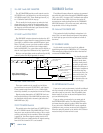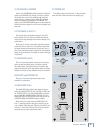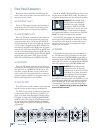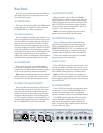
12
ONYX 1220
ONYX 1220
10. MID EQ
Short for “midrange,”
this knob provides 15 dB
of boost or cut centered
at the frequency deter-
mined by the FREQ knob
(see FREQ next), or at
2.5 kHz for the stereo
channels. Midrange EQ
is often thought of as the
most dynamic because
the frequencies that defi ne any particular sound are
almost always found in this range. You can create many
interesting and useful EQ changes by turning this knob
down as well as up.
11. FREQ
This knob ranges from
100 Hz to 8 kHz and de-
termines the center fre-
quency for the MID EQ.
This allows you to zero
in on the precise narrow
band of frequencies you
want to have affected by
the MID EQ.
12. LOW EQ
This control gives you
up to 15 dB of boost or
cut at 80 Hz. The circuit
is fl at (no boost or cut)
at the center detent
position. This frequency
represents the punch in
bass drums, bass guitar,
fat synth patches, and
some really serious male
singers.
Note: Used in conjunction with the Low Cut switch,
you can boost the LOW EQ without injecting tons of
infrasonic debris into the mix.
13. and 14. AUX 1 and 2 Sends
These tap a portion of each channel’s signal out to
either an effects processor or for stage monitoring. The
AUX Send levels are controlled by the channel’s AUX
1 and AUX 2 knobs, and by the AUX MASTER 1 and 2
knobs (26).
Since the AUX Sends are mono, the left and right sig-
nals in the stereo channels are summed together prior
to the AUX 1 and AUX 2 controls, sending the combined
signal to the AUX SEND outputs.
These are more than just effects and monitor sends.
They can be used to generate separate mixes for record-
ing, for another zone, or “mix-minuses” for broadcast.
15. PAN
PAN adjusts the amount of channel signal sent to the
left versus the right outputs. On the stereo channels
(channels 5-12), the PAN knob works like the balance
control on your home stereo (panning left turns down
the right channel, and panning right turns down the left
channel).
With the PAN knob hard left, the signal feeds either
the MAIN LEFT (bus 1) or ALT LEFT (bus 3), depend-
ing on the setting of the ALT 3/4 switch. With the knob
hard right, the signal feeds either the MAIN RIGHT (bus
2) or ALT RIGHT (bus 4).
Constant Loudness: The Onyx 1220’s
PAN control employs a design called
“Constant Loudness.” If you have a
channel panned hard left (or right)
and then pan to the center, the signal
is attenuated about 3 dB to maintain
the same apparent loudness. Otherwise, it would make
the sound appear much louder when panned center.
16. MUTE/ALT 3-4
The dual-purpose MUTE/ALT 3-4 switch is a Mackie
signature. When Greg was designing our fi rst product,
he had to include a mute switch for each channel. Mute
switches do just what they sound like they do. They turn
off the signal by “routing” it into oblivion. “Gee, what
a waste,” Greg reasoned. “Why not have the mute
button route the signal somewhere else useful, like
a separate stereo bus?” So MUTE/ALT 3-4 really serves
two functions—muting (often used during mixdown or
live shows), and signal routing (for multitrack and live
work) where it acts as an extra stereo bus.
To use this as a MUTE switch, all you have to do is
not use the ALT 3-4 outputs (49). Then, whenever you
assign a channel to these unused outputs, you’ll also be
disconnecting it from the MAIN MIX, effectively muting
the channel. The MUTE switch also disconnects the
channel from the POST AUX SEND bus. The channel’s
signal is still present on the PRE AUX SEND bus.
To use this as an ALT 3-4 switch, all you have to do is
connect the ALT 3-4 outputs (49) to whatever destina-
tion you desire. Two popular examples:
When doing multitrack recording, you can use the
ALT 3-4 outputs as a stereo or dual-mono feed to your
multitrack.
20
Hz
100
Hz
1k
Hz
10k
Hz
20k
H
z
–15
–10
–5
0
+5
+10
+15
Mid EQ
20
Hz
100
Hz
1k
Hz
10k
Hz
20k
H
z
–15
–10
–5
0
+5
+10
+15
Low EQ
20Hz 100Hz 1kHz 10kHz 20kHz
–15
–10
–5
0
+5
+10
+15
Mid EQ Freq Sweep



